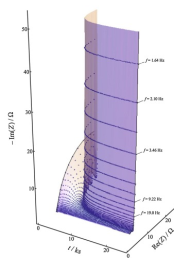
Determination of the charge transfer resistance of poly(3,4-ethylenedioxythiophene)-modified electrodes immediately after overoxidation
The paper authored by
D. Zalka,
N. Kovács,
K. Szekeres,
M. Ujvári,
S. Vesztergom,
S. Eliseeva,
V. Kondratiev and
G.G. Láng
is published in Electrochimica Acta (2017, vol. 247, pp. 321–332).
Abstract:
Many electrochemical systems are intrinsically nonstationary and are affected by time-dependent phenomena. The requirement of stationarity in the classical version of impedance spectroscopy appears to be in conflict with the essential properties of the object, therefore a post-experimental mathematical/analytical procedure is necessary for the reconstruction of the “true” impedance values. In this study, it has been shown that the 4-dimensional analysis method, originally proposed by Stoynov, can not only be used for the correction of existing (experimentally measured) impedance data, but it also opens up the possibility of the estimation of impedance spectra outside the time interval of the measurements. As an illustrative example the method has been applied for the determination of the charge transfer resistance (Rct) of poly(3,4-ethylenedioxytiophene) (PEDOT) modified electrode as a function of time, including the Rct value corresponding to the time instant just after overoxidation of the polymer film. After the overoxidation the charge transfer resistance decreased continuously with experiment time to a value somewhat higher than the Rct of the pristine electrode. The results imply that a “healing process” may occur at the film/substrate interface. A better understanding of this effect may have an impact on practical applications.
